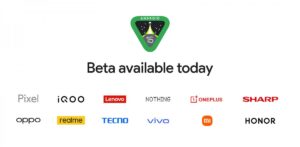Android 15’s second beta was released today by Google. Android 15 Beta is now available on “handsets, tablets, and foldable form factors” from Honor partners including iQOO, Lenovo, Nothing, OnePlus, Oppo, Realme, Sharp, Tecno, vivo, and Xiaomi.

The next beta should arrive in June, followed by a final beta in July, and then the final release will take place. If you want to install Android 15 Beta on a supported Pixel, just go to this website and enroll it. As an over-the-air update, you’ll receive the second beta.
Private Space:
This beta introduces Private space, which allows you to keep sensitive apps away from prying eyes – like you’ve been able to do on multiple Android skins for years. Still, it’s nice to see this functionality finally added to Google’s Android operating system.
If private space is locked, the user profile is paused, so the apps in it are no longer active. Private space can be locked using the device lock or a separate lock factor, and its apps appear in a separate container in the launcher. When the Private space is locked, they are also hidden from recents, notifications, settings, and other apps.
Private space and main space are used for user generated and downloaded media, files, and accounts. Apps can access content across spaces using the system share sheet and photo picker, but only when the Private space is unlocked.
Other features:
Google promises smoother transitions with Android 15. A new feature prevents apps from running in an active, foreground state for more than six hours to prevent battery drain. When hardware decoding is not supported, there is a more efficient software decoder for AV1.
Apps that frequently request access to photos and videos can highlight only the most recently selected photos and videos if they have partial media permissions.
You are also protected from malicious background apps, as they cannot bring other apps to the foreground, elevate their privileges, or “abuse user interaction”. By overlaying themselves on top of another app’s activity, malicious apps can create the illusion that they are the non-malicious app they started.
You can quickly switch between apps by pinning the taskbar on the screen on large screens. Like you could on some third-party skins for years, you can also save your favorite split-screen app combinations for quick access. As a result of the new changes, Picture-in-Picture mode should also operate more smoothly.
For apps that have properly implemented this feature, widgets can give you a better idea of how the widget will look before you add it, while predictive back shows you where the action will take you.
With Google’s Health Connect, you can also set rich vibrations for incoming notifications by channel.





